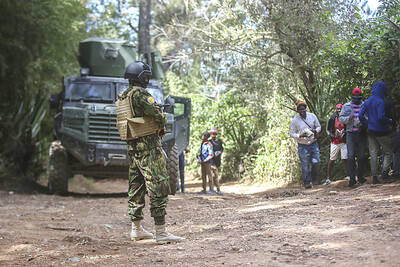Scientists in Japan would try to grow human organs in animals after receiving government permission for the first study of its kind in the country.
The cutting-edge — but controversial — research involves implanting modified animal embryos with human “induced pluripotent stem” (iPS) cells that can be coaxed into forming the building blocks of any part of the body.
It is the first step in what researchers caution is a long path toward a future where human organs for transplant could be grown inside animals.
The research led by Stanford University genetics professor Hiromitsu Nakauchi is the first of its kind to receive government approval after Japan changed its rules on implanting human cells into animals.
Japan had previously required researchers to terminate animal embryos implanted with human cells after 14 days and prevented the embryos from being placed into animal wombs to develop.
However, those restrictions were dropped in March, allowing researchers to seek individual permits for research projects.
“It took nearly 10 years, but we are now able to start the experiment,” Nakauchi said.
The research involves generating animal embryos — mice, rats or pigs — that lack a particular organ such as a pancreas.
The modified embryos are then implanted with human iPS cells that can grow into the missing pancreas.
The embryos would be transplanted into wombs where they could theoretically be carried to term with a functioning human pancreas.
Preliminary research has produced some promising signs, including the successful growth of mice pancreases in rats.
The pancreases, when transplanted back into mice, functioned successfully and controlled blood glucose levels in diabetic mice.
However, other tests have been more complicated: Researchers were able to grow mice kidneys in rats, but rat stem cells implanted in mice failed to take.
Even though the mice kidneys developed properly in rats, the rats died shortly after birth because of complications related to the way that they were modified before receiving the mice stem cells.
Nakauchi said that the newly approved study would help understand the obstacles in the field, and cautioned that he was far from the eventual goal of trying to grow human organs in pigs.
“Although we have shown proof-of-concept studies using rodent models, to overcome the genetic distance between human and pig is not easy,” he said. “The study is just about to begin. Do not expect that we are generating human organs in a year or two.”
Implanting animal embryos with human cells creates what is known as a chimera — an entity with both animal and human cells.
The process throws up complex ethical issues, particularly over concerns that it might not be possible to completely control which organs are formed in the animal by the human iPS cells.
Rules on the process differ by country: The US has no federal restrictions on creating chimeras, while other countries prohibit chimeras being kept alive beyond two weeks.
Ethicists fear that chimeras with human brain or reproductive cells would pose serious questions about the nature of the animal being tested.
Nakauchi said that his team would be proceeding with extreme caution given the ethical concerns.
“At each step we examine embryos for the presence of human cells in the brain,” Nakauchi said. “After confirming the absence or few human cells, we go to the next step.”

A French-Algerian man went on trial in France on Monday for burning to death his wife in 2021, a case that shocked the public and sparked heavy criticism of police for failing to take adequate measures to protect her. Mounir Boutaa, now 48, stalked his Algerian-born wife Chahinez Daoud following their separation, and even bought a van he parked outside her house near Bordeaux in southwestern France, which he used to watch her without being detected. On May 4, 2021, he attacked her in the street, shot her in both legs, poured gasoline on her and set her on fire. A neighbor hearing

DEATH CONSTANTLY LOOMING: Decades of detention took a major toll on Iwao Hakamada’s mental health, his lawyers describing him as ‘living in a world of fantasy’ A Japanese man wrongly convicted of murder who was the world’s longest-serving death row inmate has been awarded US$1.44 million in compensation, an official said yesterday. The payout represents ¥12,500 (US$83) for each day of the more than four decades that Iwao Hakamada spent in detention, most of it on death row when each day could have been his last. It is a record for compensation of this kind, Japanese media said. The former boxer, now 89, was exonerated last year of a 1966 quadruple murder after a tireless campaign by his sister and others. The case sparked scrutiny of the justice system in

DITCH TACTICS: Kenyan officers were on their way to rescue Haitian police stuck in a ditch suspected to have been deliberately dug by Haitian gang members A Kenyan policeman deployed in Haiti has gone missing after violent gangs attacked a group of officers on a rescue mission, a UN-backed multinational security mission said in a statement yesterday. The Kenyan officers on Tuesday were on their way to rescue Haitian police stuck in a ditch “suspected to have been deliberately dug by gangs,” the statement said, adding that “specialized teams have been deployed” to search for the missing officer. Local media outlets in Haiti reported that the officer had been killed and videos of a lifeless man clothed in Kenyan uniform were shared on social media. Gang violence has left

US Vice President J.D. Vance on Friday accused Denmark of not having done enough to protect Greenland, when he visited the strategically placed and resource-rich Danish territory coveted by US President Donald Trump. Vance made his comment during a trip to the Pituffik Space Base in northwestern Greenland, a visit viewed by Copenhagen and Nuuk as a provocation. “Our message to Denmark is very simple: You have not done a good job by the people of Greenland,” Vance told a news conference. “You have under-invested in the people of Greenland, and you have under-invested in the security architecture of this